Understanding the dietary needs of sugar gliders is crucial for their health and well-being. “What do sugar gliders eat?” is a common question among those interested in these adorable marsupials as pets. Discovering their natural dietary preferences and providing a balanced diet is key to ensuring their nutritional requirements are met.
What Do Sugar Gliders Eat: Explore Everything
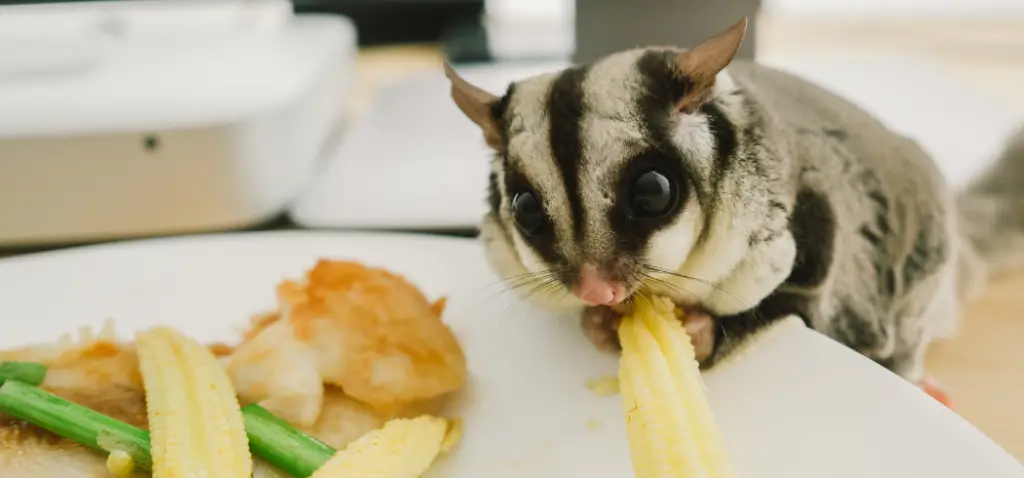
Sugar gliders are fascinating small marsupials native to Australia, Indonesia, and Papua New Guinea. They can glide through the air between trees, thanks to a membrane that stretches from their wrists to their ankles.
As nocturnal animals, they spend the majority of their day resting in nests and become active at night in search of food. But what exactly do these adorable creatures eat in their natural habitat and in captivity?
In the wild, sugar gliders primarily consume a diverse diet of nectar, fruits, insects, and even small vertebrates. They have been known to consume honeydew, tree gum, and pollen as well.
However, when kept as pets, their dietary needs change slightly to ensure they’re receiving the proper nutrients to maintain a healthy lifestyle. Providing a well-balanced diet for a sugar glider is crucial for their overall health and well-being.
When it comes to feeding sugar gliders in captivity, owners must pay close attention to the combination of their diet. The main components include protein, fruits, vegetables, and a calcium supplement. The balance of these components is essential for providing energy, maintaining good health, and supporting the sugar glider’s growth and development.
Sugar Glider Diet Fundamentals
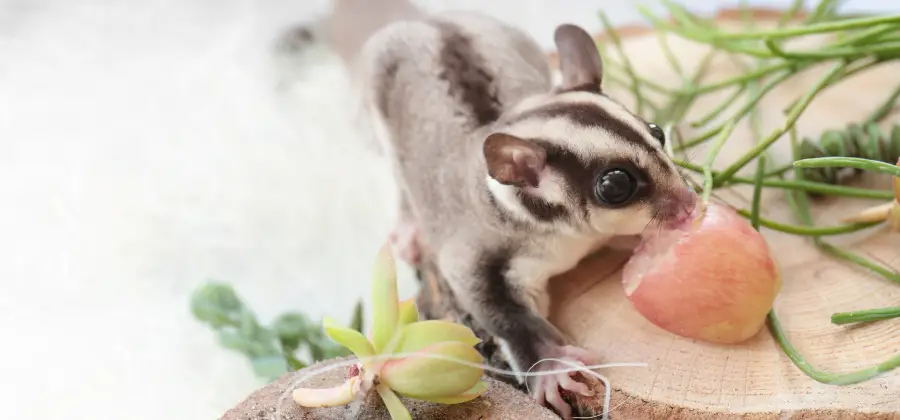
Sugar gliders are small marsupials native to Australia, New Guinea, and Indonesia that enjoy a varied and omnivorous diet. Captive sugar gliders need a well-balanced diet to maintain optimal health, and it’s essential to replicate their natural food sources as much as possible.
In this section, we will explore the main components of a sugar glider’s diet, including fruits and vegetables, insects, and sap and nectar.
Fruits and Vegetables
Fresh fruits and vegetables make up a significant part of a sugar glider’s diet, providing essential vitamins and minerals. Some popular fruits that can be fed to sugar gliders include:
- Apples
- Pears
- Peaches
- Kiwi
- Grapes
- Melons
- Berries
When it comes to vegetables, consider offering options like:
- Broccoli
- Carrots
- Peas
- Green beans
- Sweet potatoes
Remember always to feed your sugar glider a wide variety of fruits and vegetables, as offering only one or two options can lead to deficiencies in vitamins or minerals.
Insects
Insects are an essential source of protein for sugar gliders. They are known to consume a variety of bugs in the wild, including ants, termites, spiders, and moths. In captivity, you can offer these protein-rich insects:
- Mealworms
- Crickets
- Fruit flies
- Roaches
Feeding live insects can help stimulate the sugar glider’s natural hunting instincts, but always ensure the insects are free of pesticides and insecticides.
Sap and Nectar
In their natural habitats, sugar gliders enjoy a diet rich in tree sap and nectar, which provides them with a readily available source of carbohydrates, vitamins, and minerals. It is also essential for maintaining healthy energy levels, especially for these nocturnal animals, who are known to be active during the night.
To replicate this aspect of their diet in captivity, sugar gliders can be offered small amounts of honey or honeydew melon. You can also provide them with a nectar mix made from water, glucose, and other essential nutrients.
Incorporating these three main components – fruits and vegetables, insects, and sap and nectar – into your sugar glider’s diet can provide them with the necessary nutrition to maintain a healthy and active lifestyle. Keep in mind that variety and balance are key to ensuring a happy and well-nourished sugar glider.
Importance of a Balanced Diet
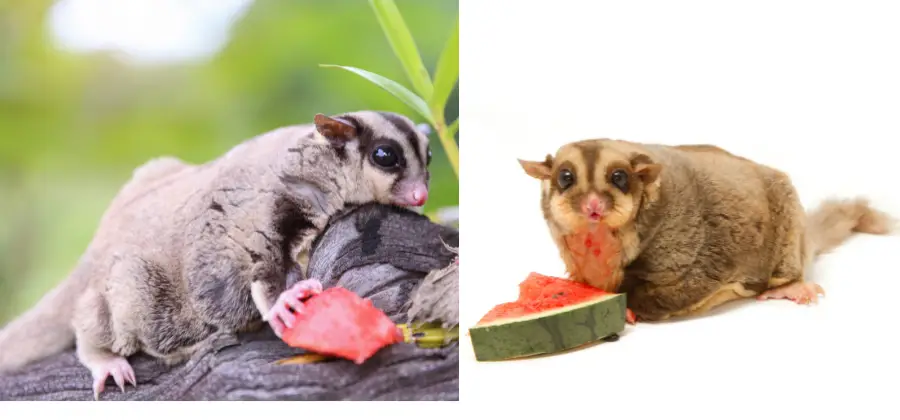
A balanced diet is crucial for sugar gliders to thrive and maintain optimal health. This adorable marsupial requires a mix of proteins, carbohydrates, fats, vitamins, and minerals to support growth, energy, and a strong immune system.
One key aspect to consider when feeding sugar gliders is their need for adequate calcium. Providing a calcium supplement can promote strong bones and prevent calcium deficiency-related issues, such as hind leg paralysis.
There are various recipes and ready-made mixes available that have balanced calcium content, which can be part of their daily meals.
Another vital component of a sugar glider’s diet is the variety of fruits and vegetables they can eat. Foods such as apples, bananas, grapes, carrots, sweet potatoes, broccoli, spinach, cucumbers, kale, and romaine lettuce are excellent options to provide essential vitamins and minerals. However, remember not to overfeed, as sugar gliders eat around 15% to 20% of their body weight daily.
Here are some important points for sugar glider diet balance:
- Protein intake: around 24% or 1 tablespoon per day
- Calcium supplement: essential for bone health
- Fruit and vegetable variety: high in vitamins and minerals
It’s just as important to know what to avoid feeding sugar gliders. Chocolate is a definite no, as it contains theobromine and caffeine, which are toxic to sugar gliders. Additionally, avoid giving them food items that are high in refined sugar, as they can lead to dental issues and obesity.
By providing a balanced diet and being mindful of their specific nutritional needs, you can ensure that your sugar glider enjoys a long, healthy, and active life.
Foods to Avoid
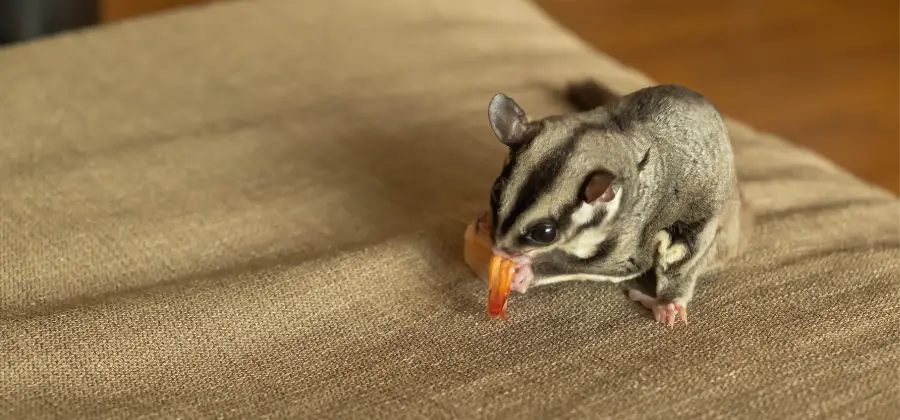
When it comes to sugar gliders’ diet, there are certain foods that should be avoided for their health and well-being. Let’s take a look at some of these foods and why they should be kept off the menu for these cute little creatures.
First and foremost, sugar gliders should not be given dairy products. This is because they are lactose intolerant and cannot break down the lactose in dairy. Feeding them dairy products may cause gastrointestinal problems, bloating, and discomfort.
In addition, sugar gliders must avoid grapes and raisins. These fruits can be toxic to these small animals and may lead to a life-threatening illness called renal failure. According to Pet Food Guide, deep-fried foods should also be excluded from their diet due to oxalates that can impair calcium absorption.
For sugar gliders, lettuce is a no-go as it lacks nutritional value and can cause diarrhea. As mentioned by Pocket Pets, sticking to healthier options like pine nuts and sunflower seeds is a better choice.
Here’s a list of some other foods to avoid for sugar gliders:
- Chocolate
- Onions
- Garlic
- Artificial sweeteners
- High-fat or salty foods
Remember, it is essential to provide a balanced and nutritious diet for sugar gliders to promote their health and happiness.
What Do Sugar Gliders Eat: Watch this video to know the answer.
Habitat and Behavior
Natural Habitat
Sugar gliders are small, tree-dwelling marsupials native to Australia, Indonesia, and Papua New Guinea. They live in various types of forests, including eucalyptus and acacia forests. Being nocturnal creatures, they are most active at night and spend their days sleeping in tree hollows or nests made from leaves.
These possums are known for their incredible gliding membrane, which helps them glide from tree to tree, covering distances up to 165 feet. They have highly social behavior and live in small groups called colonies. They communicate with each other using unique sounds and scent glands to mark their territory.
Captive Environment
When keeping sugar gliders as pets, it’s vital to replicate their natural habitat as closely as possible. Providing a large cage with plenty of vertical space, branches, and hiding spots will encourage their arboreal and gliding behaviors. A proper temperature of 75°F to 80°F (24°C to 27°C) should be maintained in their environment.
Sugar gliders require a mix of fixtures inside their cage, such as:
- Nesting boxes to mimic tree hollows
- Ropes or branches for climbing
- Gliding poles or platforms for launching
Since these marsupials are social animals, it’s recommended to keep at least two sugar gliders together for companionship. In captivity, their diet should mimic their natural food sources, including fruits, vegetables, insects, and a commercial sugar glider diet that meets their nutritional needs.
Regular interaction and handling will help them become more comfortable and friendly toward their owner.
Remember, sugar gliders are nocturnal animals, so their activity will peak during the night. It’s essential to be aware of their behavior and provide an environment that allows them to thrive and exhibit their natural instincts.
Caring for a Sugar Glider as a Pet
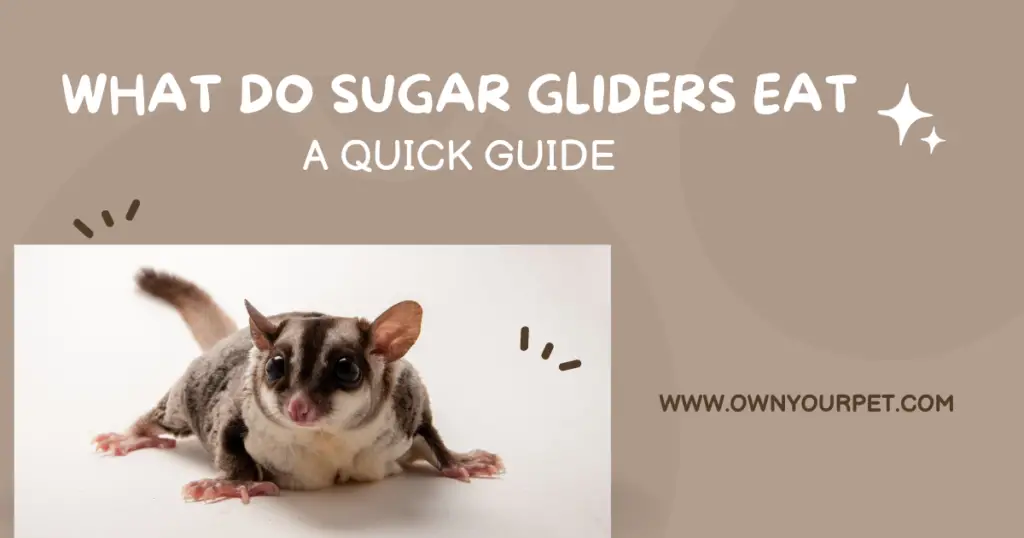
Housing and Enrichment
Sugar gliders (Petaurus breviceps) are small nocturnal animals that require proper housing to ensure their well-being. To accommodate their active lifestyle, a tall cage with ample space for climbing and jumping is necessary. The minimum cage size should be 24″x24″x36″ for one or two gliders.
Equip the habitat with branches, ropes, and shelves, giving them plenty of room to play and exhibit their natural behaviors. Install a nest box in the cage where they can sleep during the day, as they’re nocturnal animals.
To prevent obesity and keep your pet active, provide a variety of toys and exercise equipment, such as:
- Exercise wheels (ensure they’re “glider safe” with a solid surface to avoid injury)
- Hanging toys and bridges
- Foraging toys to stimulate their natural hunting instincts
In addition to their housing, keep their environment temperature at around 75-80°F, and maintain controlled exposure to sunlight for their overall health.
Health and Veterinary Care
Regular visits to a veterinarian specializing in exotic pets are essential to maintain your sugar glider’s health. Keep an eye on their weight and diet, as obesity can be a common issue for captive sugar gliders.
A well-balanced diet is crucial for their well-being. Offer a combination of pellets, a homemade balanced diet, and a variety of fresh fruits, vegetables, and nuts. Offer healthy sources of protein (25%), such as insects, mealworms, or lean meats.
If you notice any signs of illness, such as lethargy, weight loss, or changes in appetite, consult your veterinarian immediately.
Can sugar gliders eat human food?
While sugar gliders can occasionally have small amounts of certain human foods, it is important to be cautious. Some safe options include small amounts of fresh fruits, vegetables, and cooked lean meats. However, many human foods, such as chocolate, caffeine, processed foods, and foods high in sugar or salt, can be harmful or toxic to sugar gliders and should be avoided.
Socialization and Handling
Sugar gliders are social creatures and require regular interaction with their pet parents or other gliders to thrive. As a pet owner, it’s essential to patiently establish trust and build a bond with your sugar glider through gentle handling and positive reinforcement.
Begin with short handling sessions in a calm, quiet environment and gradually increase the time you spend together as your pet becomes more comfortable.
Incorporate playtime and socialization into your daily routine, ensuring you interact with them during their active nighttime hours. If you’re introducing a new glider to an existing group or pairing them with another pet, be patient and closely monitor their interactions to prevent any aggression or territorial disputes.
By considering these aspects of housing, health, and socialization, you’ll be well-equipped to care for your sugar glider as a loving and responsible pet parent.
